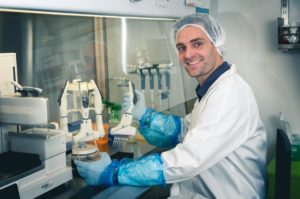
Pre-clinical research into deadly brain cancer, Parkinson’s, dementia, epilepsy and other major psychiatric and neurological conditions can speed up with the global commercialisation of an advanced neuromedium, called BrainPhys™.
As outlined in Nature Communications, medical scientists in Australia and North America have given the BrainPhys™ Imaging (BPI) technology the thumbs-up, especially in vital work with live neurons in-vitro.
BrainPhys closely mimics the chemical environment of the healthy living brain, providing a platform for researchers to model a patient’s disease in a laboratory, paving the way for more personalised research on individual disorders.
With commercial partner STEMCELL Technologies, the laboratory medium was formulated by Flinders University senior research fellow , who leads the Laboratory for Human Neurophysiology and Genetics based at the South Australian Health and Medical Research Institute (SAHMRI).
is working on better personalised medicine for brain disorders, including Parkinson’s, brain cancer and a form of childhood dementia, using avatars of individual human brains.
The use of human pre-clinical models is vital to boost the success of clinical trials in neurology, he says.

“We developed this medium to support optimal neuronal function and viability in live imaging experiments using patient-derived brain cells in vitro, and this study shows that BrainPhys Imaging is superior in a wide range of fluorescent imaging settings,” Dr Bardy says.
He says biotechnological innovations are extremely important in the quest to find treatments and cures for these devastating diseases, which currently have few treatment options and often result in painful death.
The article, (2020), by M Zabolocki, K McCormack, M van den Hurk, B Milky, A Shoubridge, R Adams, J Tran, A Mahadevan-Jansen, P Reineck, J Thomas, MR Hutchinson, C Mak, A Añonuevo, LH Chew, AJ Hirst, VM Lee, E Knock and C Bardy has been published in Nature Communications DOI: 10.1038/s41467-020-19275-x
The research was funded by Flinders Foundation, Perpetual Impact Philanthropy, the Brain Foundation, Rebecca L. Cooper Foundation, Ian Potter Foundation, Boileau Corporate Philanthropy, Parkinson’s SA, MRFF Australian Government and Department of Health, Australian Research Council LIEF grant, Centre for Nanoscale and Biophotonics, Future Fellowship, US ³Ô¹ÏÍøÕ¾ Research Council Senior Fellow Program to the US Air Force Research Laboratory, the Netherlands Organisation for Scientific Research Rubicon Fellowship, RMIT University Vice-Chancellor’s Research Fellowship, and Australian Government Research Training Program Scholarship. Flow cytometry analysis and cell sorting were performed at SAHMRI in the ACRF Cellular Imaging and Cytometry Core Facility. The facility is generously supported by the Detmold Hoopman Group, Australian Cancer Research Foundation and Australian Government through the Zero Childhood Cancer Program.







